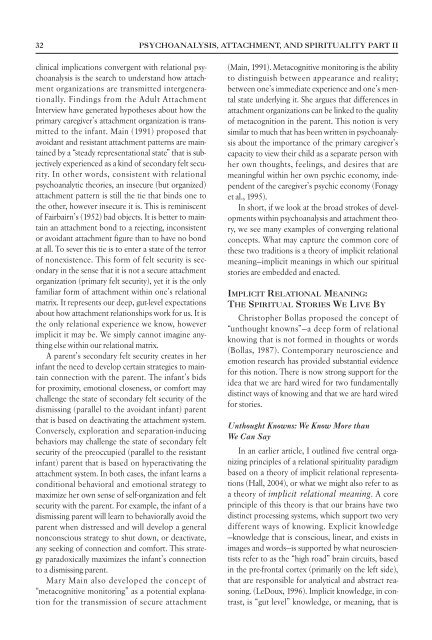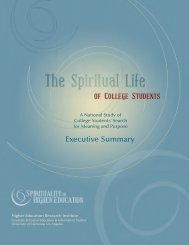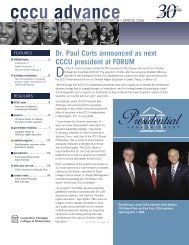Psychoanalysis, Attachment, and Spirituality Part II ... - Dr. Todd Hall
Psychoanalysis, Attachment, and Spirituality Part II ... - Dr. Todd Hall
Psychoanalysis, Attachment, and Spirituality Part II ... - Dr. Todd Hall
Create successful ePaper yourself
Turn your PDF publications into a flip-book with our unique Google optimized e-Paper software.
32 PSYCHOANALYSIS, ATTACHMENT, AND SPIRITUALITY PART <strong>II</strong><br />
clinical implications convergent with relational psychoanalysis<br />
is the search to underst<strong>and</strong> how attachment<br />
organizations are transmitted intergenerationally.<br />
Findings from the Adult <strong>Attachment</strong><br />
Interview have generated hypotheses about how the<br />
primary caregiver’s attachment organization is transmitted<br />
to the infant. Main (1991) proposed that<br />
avoidant <strong>and</strong> resistant attachment patterns are maintained<br />
by a “steady representational state” that is subjectively<br />
experienced as a kind of secondary felt security.<br />
In other words, consistent with relational<br />
psychoanalytic theories, an insecure (but organized)<br />
attachment pattern is still the tie that binds one to<br />
the other, however insecure it is. This is reminiscent<br />
of Fairbairn’s (1952) bad objects. It is better to maintain<br />
an attachment bond to a rejecting, inconsistent<br />
or avoidant attachment figure than to have no bond<br />
at all. To sever this tie is to enter a state of the terror<br />
of nonexistence. This form of felt security is secondary<br />
in the sense that it is not a secure attachment<br />
organization (primary felt security), yet it is the only<br />
familiar form of attachment within one’s relational<br />
matrix. It represents our deep, gut-level expectations<br />
about how attachment relationships work for us. It is<br />
the only relational experience we know, however<br />
implicit it may be. We simply cannot imagine anything<br />
else within our relational matrix.<br />
A parent’s secondary felt security creates in her<br />
infant the need to develop certain strategies to maintain<br />
connection with the parent. The infant’s bids<br />
for proximity, emotional closeness, or comfort may<br />
challenge the state of secondary felt security of the<br />
dismissing (parallel to the avoidant infant) parent<br />
that is based on deactivating the attachment system.<br />
Conversely, exploration <strong>and</strong> separation-inducing<br />
behaviors may challenge the state of secondary felt<br />
security of the preoccupied (parallel to the resistant<br />
infant) parent that is based on hyperactivating the<br />
attachment system. In both cases, the infant learns a<br />
conditional behavioral <strong>and</strong> emotional strategy to<br />
maximize her own sense of self-organization <strong>and</strong> felt<br />
security with the parent. For example, the infant of a<br />
dismissing parent will learn to behaviorally avoid the<br />
parent when distressed <strong>and</strong> will develop a general<br />
nonconscious strategy to shut down, or deactivate,<br />
any seeking of connection <strong>and</strong> comfort. This strategy<br />
paradoxically maximizes the infant’s connection<br />
to a dismissing parent.<br />
Mary Main also developed the concept of<br />
“metacognitive monitoring” as a potential explanation<br />
for the transmission of secure attachment<br />
(Main, 1991). Metacognitive monitoring is the ability<br />
to distinguish between appearance <strong>and</strong> reality;<br />
between one’s immediate experience <strong>and</strong> one’s mental<br />
state underlying it. She argues that differences in<br />
attachment organizations can be linked to the quality<br />
of metacognition in the parent. This notion is very<br />
similar to much that has been written in psychoanalysis<br />
about the importance of the primary caregiver’s<br />
capacity to view their child as a separate person with<br />
her own thoughts, feelings, <strong>and</strong> desires that are<br />
meaningful within her own psychic economy, independent<br />
of the caregiver’s psychic economy (Fonagy<br />
et al., 1995).<br />
In short, if we look at the broad strokes of developments<br />
within psychoanalysis <strong>and</strong> attachment theory,<br />
we see many examples of converging relational<br />
concepts. What may capture the common core of<br />
these two traditions is a theory of implicit relational<br />
meaning—implicit meanings in which our spiritual<br />
stories are embedded <strong>and</strong> enacted.<br />
IMPLICIT RELATIONAL MEANING:<br />
THE SPIRITUAL STORIES WE LIVE BY<br />
Christopher Bollas proposed the concept of<br />
“unthought knowns”—a deep form of relational<br />
knowing that is not formed in thoughts or words<br />
(Bollas, 1987). Contemporary neuroscience <strong>and</strong><br />
emotion research has provided substantial evidence<br />
for this notion. There is now strong support for the<br />
idea that we are hard wired for two fundamentally<br />
distinct ways of knowing <strong>and</strong> that we are hard wired<br />
for stories.<br />
Unthought Knowns: We Know More than<br />
We Can Say<br />
In an earlier article, I outlined five central organizing<br />
principles of a relational spirituality paradigm<br />
based on a theory of implicit relational representations<br />
(<strong>Hall</strong>, 2004), or what we might also refer to as<br />
a theory of implicit relational meaning. A core<br />
principle of this theory is that our brains have two<br />
distinct processing systems, which support two very<br />
different ways of knowing. Explicit knowledge<br />
—knowledge that is conscious, linear, <strong>and</strong> exists in<br />
images <strong>and</strong> words—is supported by what neuroscientists<br />
refer to as the “high road” brain circuits, based<br />
in the pre-frontal cortex (primarily on the left side),<br />
that are responsible for analytical <strong>and</strong> abstract reasoning.<br />
(LeDoux, 1996). Implicit knowledge, in contrast,<br />
is “gut level” knowledge, or meaning, that is












![Download Guide [PDF] - Council for Christian Colleges & Universities](https://img.yumpu.com/37211849/1/190x245/download-guide-pdf-council-for-christian-colleges-universities.jpg?quality=85)



